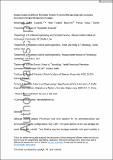Ambient Stable and Efficient Monolithic Tandem Perovskite/PbS Quantum Dots Solar Cells via Surface Passivation and Light Management Strategies
Author(s)
Tavakoli, Mohammad Mahdi; Dastjerdi, Hadi Tavakoli; Yadav, Pankaj; Prochowicz, Daniel; Si, Huayan; Tavakoli, Rouhollah; ... Show more Show less
Download10.1002-adfm.202010623.pdf (2.099Mb)
Publisher Policy
Publisher Policy
Article is made available in accordance with the publisher's policy and may be subject to US copyright law. Please refer to the publisher's site for terms of use.
Terms of use
Metadata
Show full item recordAbstract
Here, highly efficient and stable monolithic (2-terminal (2T)) perovskite/PbS quantum dots (QDs) tandem solar cells are reported, where the perovskite solar cell (PSC) acts as the front cell and the PbS QDs device with a narrow bandgap acts as the back cell. Specifically, ZnO nanowires (NWs) passivated by SnO2 are employed as an electron transporting layer for PSC front cell, leading to a single cell PSC with maximum power conversion efficiency (PCE) of 22.15%, which is the most efficient NWs-based PSCs in the literature. By surface passivation of PbS QDs by CdCl2, QD devices with an improved open-circuit voltage and a PCE of 8.46% (bandgap of QDs: 0.92 eV) are achieved. After proper optimization, 2T and 4T tandem devices with stabilized PCEs of 17.1% and 21.1% are achieved, respectively, where the 2T tandem device shows the highest efficiency reported in the literature for this design. Interestingly, the 2T tandem cell shows excellent operational stability over 500 h under continuous illumination with only 6% PCE loss. More importantly, this device without any packaging depicts impressive ambient stability (almost no change) after 70 days in an environment with controlled 65% relative humidity, thanks to the superior air stability of the PbS QDs.
Date issued
2021-03-18Department
Massachusetts Institute of Technology. Department of Electrical Engineering and Computer Science; Massachusetts Institute of Technology. Department of Materials Science and EngineeringJournal
Advanced Functional Materials
Publisher
Wiley
Citation
Tavakoli, M. M., Dastjerdi, H. T., Yadav, P., Prochowicz, D., Si, H., Tavakoli, R., Ambient Stable and Efficient Monolithic Tandem Perovskite/PbS Quantum Dots Solar Cells via Surface Passivation and Light Management Strategies. Adv. Funct. Mater. 2021, 31, 2010623.
Version: Author's final manuscript
ISSN
1616-301X
1616-3028